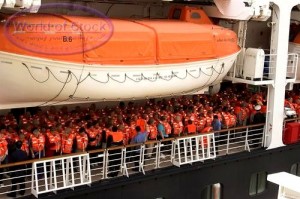
<strong>Introduction:
Once you have unpacked or may be even earlier than that, you will be asked to join a lifeboat drill at a muster station that has been assigned to you. A muster station is the place where you are required to report in case there is a problem while on board. This is done to avoid crowding at one particular place and to ensure that every one gets a seat on the lifeboat A safety drill is an emergency plan.
</strong>Why is this drill required?<strong>
This exercise is essential to make the passengers aware about the emergency evacuation plans and the necessary routes to the nearest exits along with the usage of life-jackets and precautions to be practiced if travelling with children. The children may be asked to wear bracelets containing the information about their respective muster stations so that in case of emergency the parents may collect them from their respective stations, where the members of the crew shall deliver them. This activity is usually practiced half an hour before the scheduled departure time.
The first step usually is demonstration and practice for using the life jackets properly. This is usually followed by the location of exits, location of muster stations and do and don’ts if traveling with kids. The ship’s emergency signal is usually played during the exercise to make the passengers aware. This signal is usually seven small blasts followed by one long blast. The passengers are requested to be alert during the demonstration and have to remain in silence.
The International Law states that this drill should be conducted within 24 hours of the departure. In some countries, someone who doesn’t attend the life boat drill is fined too. When the drill signal goes on, the crew members checks every room for people who are trying to escape or are unaware. This drill is very essential because it is to save the lives of the passengers during emergencies.
Image Credits: http://www.worldofstock.com/closeups/TRB1495.php






